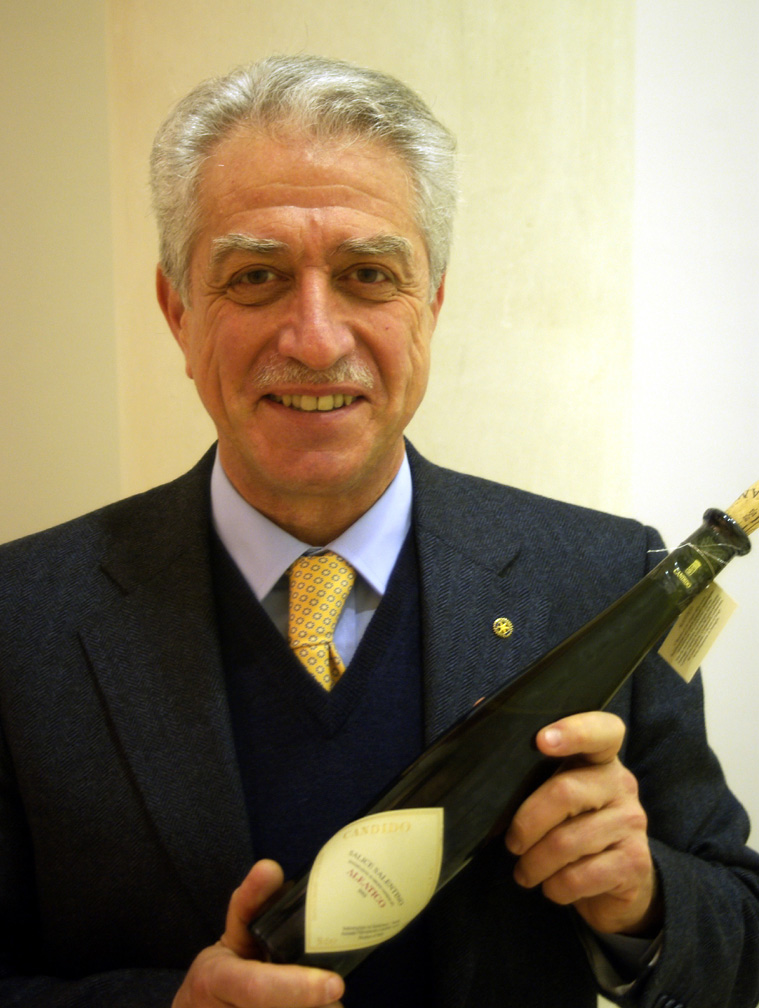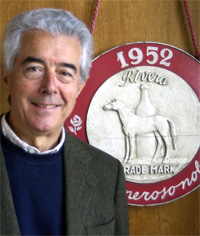A visit to Puglia and its wines
Article and photos © by Tom Hyland
I recently visited Puglia for the first time in more than six years and was eager to taste the latest wines from this beautiful region. Getting out of the cold and snow of late January in Chicago was a nice bonus, but the primary motive was to discover the direction in which Puglian wines are headed.
I certainly needed to boost my knowledge of Puglia, as my experience with these wines is lacking especially compared with bottlings from other regions such as Piemonte, Toscana and Campania. So this trip was really an eye-opening, educational encounter for me; I even learned about some DOC zones I wasn't aware of.
Given this was a three-day trip, I certainly didn't get to visit as many areas or meet as many producers as I would have liked, but I covered enough ground to get a good feel for at least a few wine zones. Just north and west of the city of Lecce in southern Puglia, the Salice Salentino DOC is one of the region's most important. Two grapes — Negroamaro and Malvasia Nera — are the varieties used, with the former being at least 80 percent of the blend. Negroamaro (literally "black bitter") gives the wine its body and tannins, so producers looking to make a version that will age a bit longer often use as much as 90 or 95 percent of this variety (Malvasia Nera adds acidity and perfume to the wine).
As you might imagine, styles of this wine vary as to the producer's individual whims, with some being quite forward and ripe, while others are more subdued in their fruit presentation and offer more earthiness. Notes of myrtle, cigar and dried brown herbs are quite common, while the tannins are rarely excessive. The best Riserva versions (from an outstanding vintage such as 2004) will drink well for another 5-7 years and perhaps a bit longer.
 |
| Alessandro Candido, Proprietor, Candido Winery. Photos © 2009 by Tom Hyland |
Every bottling of Salice Salentino I tasted was quite good and a few were excellent; combine this with its US $18-$25 sales point and you've got a great price/quality ratio. The 2005 Li Veli Riserva (imported nationally by Dalla Terra) is quite charming with soft tannins, while the 2005 Cantine due Palme Riserva "Selvarossa" is fuller and a bit riper with appealing black cherry fruit and an elegant finish. From 2004, the Riserva bottlings were routinely noteworthy, especially those from Cantele (imported nationally by Vias), Candido and Leone de Castris. This last estate's special bottling, "Donnalisa" is outstanding, with delicious black raspberry and black plum fruit, impressive concentration and silky tannins. What a marvelous food wine (especially with lamb) over the next few years.
Many wineries in the southern provinces produce wines under the Salento IGT designation. This can incorporate several varieties such as Negroamaro (some lovely rosés are made from this grape) or Primitivo, a forward, spicy red variety that shares similar DNA with Zinfandel from California. Some of the wines are made entirely from one variety, while others are blends; the IGT designation allows the winemakers this freedom. Wines in this category that impressed me included the 2006 Primitivo "Fiore di Vigna" from Paolo Leo, the 2001 Duca d'Aragona from Candido, a blend of Negroamaro and Montepulciano and the 2006 Cento su Cento from Castel di Salve, a 100 percent Primitivo that has intriguing flavors of black molasses and black plum with excellent fruit persistence, though a touch too much oak.
There were two IGT Salento wines I tried that stood out from the rest. One from Castel di Salve is the 2005 Priante, a blend of half Negroamaro and half Montepulciano. This wine offers beautiful aromas of black cherry, cigar and vanilla and has a rich mid-palate with layers of flavor. The finish is quite long and offers notes of marmalade, mint and tobacco. I can't wait to try this wine again with game in another 5-7 years!
The other wine is the 2003 Gratticaia from Agircole Vallone, a 100 percent Negroamaro. I love the complexity of this wine with its aromas of fresh cherry, cedar and pepper along with its impressive balance and structure. It is very approachable now, but I think it will be much better in another 7-10 years; this clearly was one of the most complete wines I tried from all of Puglia!
Heading much farther north, the Castel del Monte DOC (named for a famous 13th century octagonal structure impressively sited on a country hilltop) is home to many beautifully restrained, more traditional red wines. Here the primary red grape is Nero di Troia (also known as Uva di Troia). Wines made from this grape offer very good acidity and moderate tannins along with stylish black and red fruit flavors. Torre Vento produced a lovely 100 percent Nero di Troia called "Vigna Pedale" from the 2005 vintage with striking aromas of black raspberry and violets, elegant tannins and notes of black spice in the finish. The 2004 Falcone Riserva from Rivera is a blend of 70 percent Nero di Troia with 30 percent Montepulciano that offers red fruit flavors, moderate tannins and light herbal notes. The winery's 2005 Puer Apuliae, a 100 percent Nero di Troia, is a riper, more modern style wine, but one that is nicely balanced and never flashy. Deeply concentrated, this has wonderful complexity and offers beautiful aromatics of black plum and bitter chocolate; look for this wine to be at its best in 7-10 years.
 |
| Carlo de Corato, President, Rivera Wines |
I also enjoyed a marvelous 100 percent Nero di Troia from the 2006 vintage from Alberto Longo of the Lucera zone, north and west of Castel del Monte. Labeled as "Le Criuste" this has tantalizing flavors of cranberry and black plum fruit with an intriguing aroma of shiitake mushrooms — I can't recall the last time I used that descriptor in my wine notes! The tannins are moderate and the acidity is very good, making this instantly approachable, although this will offer great pleasure for another 5-7 years. Longo also produces one of Puglia's best whites, a Falanghina labeled as "Le Fosette"; the 2007 version has textbook striking acidity and tasty melon and lime flavors. For you Italian wine trivia buffs out there, Longo is also one of the few producers to make a DOC red known as Cacc'e Mmitte di Lucera, which in this case is a blend of Nero di Troia, Montepulciano and Bombino Bianco. This is a charming red with notes of red currant and strawberry with light tannins and high acidity. How nice to taste a fun, lightly spicy red such as this and how nice of Alberto Longo to keep this rare DOC from becoming extinct!
One problem that Puglian wine industry has endured for years is that only a few of its best producers have gained a reputation outside of Italy. Leave it to the Antinori family to see to that situation! Their Tormaresca wines, from two estates — one in the south and one in the north- have brought a lot of attention to Puglia over the past decade. It's nice to see the variety of price levels they work with; at $12 retail, they offer a well made Chardonnay (current vintage 2007) and a spicy red called Neprica, named for the first two letters of the three varieties in the blend: NEgroamaro, PRimitivo and CAbernet Sauvignon. The current 2007 bottling is very good and a nice accompaniment to everything from simple pastas to almost any red meat; thanks to the winery for producing a fine value like this, especially in these times!
My favorite red from Tormaresca is the 2004 Bocca di Lupo, a 100 percent Aglianico. This is one of the greatest red varieties in all of Italy and the Tormaresca version is gorgeous with textbook black cherry and bitter chocolate flavors, excellent concentration and a complete, beautifully structured finish with elegantly styled tannins. In my notes, I wrote that this should be at its best in 12-15 years, but I may be conservative in this estimate. At a suggested retail price in the US of $36, this is eminently fair, especially given its world-class quality.
For dessert wine, you have two main options in Puglia: Moscato di Trani from the north or Aleatico, made from a red variety grown throughout the region. The best Moscato di Trani I tasted was from Tormaresca; the 2006 "Kolaro" has golden raisin and pineapple flavors and a light sweetness; pair this with a pear or apple tart or a simple pound cake. For Aleatico Passito, I thoroughly enjoyed the 2002 Candido and the 2004 Castel di Salve. Both wines offer haunting aromas of caramel, orange peel and almond, with the latter bottling a bit more concentrated. Both are highly recommended versions of this unique dessert specialty, which is arguably the best wine made anywhere in the world to accompany chocolate, though I think it is special enough to enjoy on its own as a vino di meditazione. What a lovely way to finish a tasting of the wines of Puglia!
February, 2009
To contact Tom Hyland, visit his Website, "Learn Italian Wines," www.learnitalianwines.com or write him at thwinewriter@comcast.net




